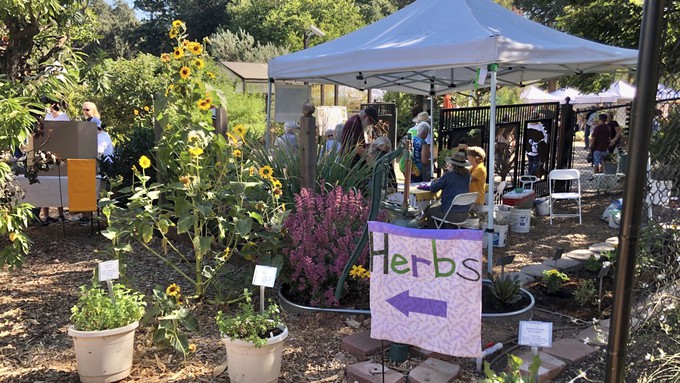
Plant talks, vendors, food and fun during annual gardening celebration

Last year's Harvest Day was busy in the Herb Garden and beyond. This year's event is Saturday, Aug. 5. Kathy Morrison
Wow, time for Harvest Day already? Yes, the summer celebration dubbed "a gardener's dream day" returns Saturday, Aug. 5, to the Fair Oaks Horticulture Center.
The Sacramento County master gardeners have been working for months to prepare the Horticulture Center and the planned programs for their showcase event, which will run from 8 a.m. to 2 p.m.
Visitors can expect to find a wealth of expert gardening advice, plus dozens of educational displays, a collection of garden specialty vendors and several food vendors.
Three 45-minute keynote gardening presentations are scheduled in the speakers' tent:
-- 8:30 a.m. Debbie Flower & "Farmer Fred" Hoffman, "Tips for Saving Time, Money & Water in the Garden"
-- 9:45 a.m. Angela Laws, "Habitat Gardening for Pollinators in a Changing World"
-- 11 a.m. Pam Bone, "Home Reforestation: Correct Planting and Establishment of Landscape Trees"
"Mini talks" also are scheduled throughout the FOHC, covering such gardening topics as drip irrigation, worm composting, grape growing, and gardening with native plants.
The 2024 edition of the popular Gardening Guide & Calendar will make its sales debut during Harvest Day. The price this year will be $12.
The Fair Oaks Horticulture Center is located at 11549 Fair Oaks Blvd., just south of the Fair Oaks Library at Madison Avenue. Admission and parking are free.
The Horticulture Center will have plenty of natural shade and pop-ups, but master gardeners recommend that each visitor bring a hat.
For more information on the Sacramento County master gardeners and Harvest Day, go to https://sacmg.ucanr.edu/Harvest_Day/
Comments
0 comments have been posted.Sacramento Digs Gardening to your inbox.
Sites We Like
Garden Checklist for week of July 21
Your garden needs you!
* Keep your vegetable garden watered, mulched and weeded. Water before 8 a.m. to reduce the chance of fungal infection and to conserve moisture.
* Feed vegetable plants bone meal, rock phosphate or other fertilizers high in phosphate to stimulate more blooms and fruiting. (But wait until daily high temperatures drop out of the 100s.)
* Don’t let tomatoes wilt or dry out completely. Give tomatoes a deep watering two to three times a week.
* Harvest vegetables promptly to encourage plants to produce more. Squash especially tends to grow rapidly in hot weather. Keep an eye on zucchini.
* Pinch back chrysanthemums for bushy plants and more flowers in September.
* Remove spent flowers from roses, daylilies and other bloomers as they finish flowering.
* Pinch off blooms from basil so the plant will grow more leaves.
* Cut back lavender after flowering to promote a second bloom.
* It's not too late to add a splash of color. Plant petunias, snapdragons, zinnias and marigolds.
* From seed, plant corn, pumpkins, radishes, winter squash and sunflowers.